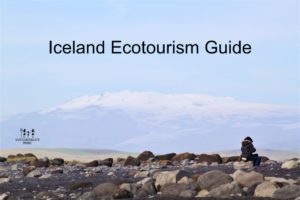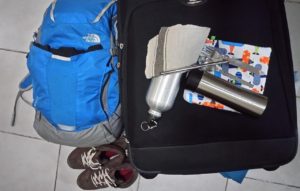Hello Tribe, out of all my travels till now, my solo travel to Iceland stands out. Firstly, for that ‘out of this world’ natural beauty of Iceland and secondly for those numerous opportunities of learning about our planet’s natural history, some of its secrets hidden beneath the surface! After exploring Iceland for a week, I rate Iceland as one of the best Ecotourism destinations. So here I am bringing you the first of its kind, an exclusive Sustainable Travel Guide to Iceland. You can also download a short version of this Iceland ecotourism guide at the end of this article.
It was always my dream to go to a faraway place alone and explore the culture and natural beauty on my own, basically solo travel. But somehow this remained more of a thought and I didn’t act on it. But after I turned 30, I kept on thinking about my top bucket list item, northern lights tour. So I decided to take time off for myself to travel on my own. My husband supported me by taking a week off from work and by becoming a fulltime daddy for a week. To make great use of this opportunity, I decided to combine my passion for Ecotourism, love for Nature along with ticking a few of my bucket list items. The best part was, my Iceland trip gave me everything I was looking for in just one week of travel. Since then many people have been asking me why did I select Iceland as my first solo trip destination.
The answer is a bit lengthy, so here is a list of reasons why I chose Iceland,

Flying from Dubai, I had to take a few connecting flights to reach Iceland. The last part of my journey to Iceland, I took Iceland air and was happy to get my meal in an Eco-friendly packaging instead of standard plastic packaging. So I tried to find more about Iceland Air; they use greener aircraft and navigation system. Also, Iceland air offices use electricity from 100% renewable resources.
After I landed at Keflavik airport, on the way out I noticed a bike pit in the airport premise, a bicycle stand. Though it was raining at the time I landed and considering the distance of Keflavik airport from Reykjavik city center, riding on a bicycle to reach airport felt a hard thing to do at that moment. But it was a pleasant surprise and gave me a glimpse of Icelandic outdoor lifestyle. As a tourist, you can hire bikes near an old harbor in Reykjavik and also can take tours from Reykjavik Bike Tours.
But I would recommend it’s best to explore Reykjavik on foot. It is a beautiful and walkable city with lots of public green spaces. The central Laugavegur street, where most of the shopping, eating out venues are located is mostly car-free. So best is to either use cycle or walk.
To explore the outskirts of Reykjavik or go from one city to another in Iceland or for site seeing you can use public buses, the main bus station (or terminal) BSI is centrally located near Laugavegur street.
I feel no travel is complete without trying the local delicacies. When you read any Iceland travel guide you find the most common suggestions for Icelandic delicacies their famous hot dog at Baejarins Beztu in Reykjavik and dry fish snacks, hakarl which you can find in any grocery store in Iceland. But don’t worry Iceland’s food scene doesn’t end there. You can definitely find really nice, local even vegan food in Iceland and if you are keen, there are also Iceland culinary tours.
Iceland’s barren land which is mostly covered with geothermal fields didn’t help Icelanders to evolve traditional farming in Iceland. Year-round colder weather and the fact that this is one of the youngest formed landmasses which has a very thin layer of volcanic soils and below that is mostly lava fields make Iceland a very uncultivable environment. Even since the deforestation after early settlement in Iceland, this delicate ecosystem could not thrive and now you hardly get to see naturally grown tall trees here. However, thanks to their huge coastline and inland rivers, seafood has been their main staple. You can get a great selection of fresh and local seafood in many restaurants near Reykjavik harbor.
However, since more than 60-70 years, the green agricultural methods are developed and established in Iceland. The local farming community farms many vegetables and fruits locally in greenhouses which are powered by geothermal energy, which makes the food coming from local farms sustainable food!
Right from tropical fruits like bananas to all your regular vegetables are grown in these greenhouses year-round. I tried the tomato soup in Fridheimar farm, which is voted as best tomato soup in the world. This farm is also visited by many celebrities like Bill Clinton. Read more about my sustainable food tour in Iceland and how this geothermally powered farm works. In the same sustainable food tour, I also tried Icelandic delicacy, Skyr on a cattle farm, which is a staple in Icelandic breakfast.
If you can’t make it to these farms, you can simply buy the fresh vegetables and fruits in a nearby grocery store in Reykjavik and prepare your own meal. This could be a great budget-friendly travel tip as eating out in Iceland can be expensive.
There are also many vegan and vegetarian restaurants in Reykjavik, you can try Bergsson Mathus, Glo to name a few. You can find a list of restaurants to try in the downloadable ‘Iceland Sustainable Travel Guide’ at the end of this article.
If you are in Iceland for a layover and you have only a day or two to explore Reykjavik, I highly recommend this list of Top 10 sustainable things to do in Reykjavik, most of these things are free or budget-friendly and don’t need any advance booking but you can still cover many top rated places around Reykjavik.
In this list, there are also things like Whale watching, Icelandic Horse riding which you need to book in advance. And if you are lucky enough you can watch northern lights from Reykjavik city, without booking any trip!
Golden Circle tour is a day trip from Reykjavik which includes the protected Thingvellir National Park, where you get to see a UNESCO world heritage site of world’s first parliament, known as the open-air parliament. At the Thingvellir national park, you also get to see ‘between the continent’ fissure zone. Actually, Iceland is located at the mid-Atlantic ridge and this fissure zone runs across the country where two tectonic plates of Eurasia and North America meet. So technically the whole of Iceland is ‘between the two continents’. Lake Þingvallavatn, the largest natural lake in Iceland where new species of fish are discovered is located in this park. Here in Silfra fisher, you can snorkel between two continents in one the world’s most clear waters.
The next stop on the Golden circle is Strokkur geyser of Haukadalur geothermal area, where I was lucky to be able to watch the rare double eruption. Gullfoss is generally the last stop on this tour before you return to Reykjavik.
Read here, more details of the Golden Circle tour. You can also combine Farm to table food trail and Lava caving (read below) experience with Golden Circle tour and return back to Reykjavik after dinner.
Still not very popular amongst the tourist, but this is a great Eco-adventure which you should not miss in Iceland. This is a tour of an irregular natural lava tube cave formed millions of years back. In this cave you walk, you crawl or even roll to fit in the gaps while you keep marveling at nature’s way of sculpting many different formations like Stalagmites, Stalactite. Sounds a bit scary? Don’t worry you will come out alive even if you have claustrophobia like me, just find a knowledgeable and experienced guide! However, be warned not to venture in the cave on your own without the expert guide, as the cave has many branches inside and you don’t want to get lost there. You can see or experience the real pitch dark only in places like these. Read here my thrilling experience of Lava tube cave tour at Leidarendi Cave on the way back from golden circle tour.
This was the main reason why I traveled to Iceland. Iceland is a great place to see Northern lights or Aurora Borealis. Plus unlike many other northern lights destinations, you have lot many options of sightseeing during the day in Iceland. If you are lucky enough and the northern lights activity is high enough, you can see it from Reykjavik or even from your plane to Iceland!
Read more details of Northen Lights tour including all the facts, tips and my experience of watching dancing northern lights and preparation tips for your trip! Just be careful, and watch out for cars even on empty roads; if you are close to the road while watching the northern lights.
You can not leave Iceland without seeing at least one glacier and a few volcano mountains. There is a total of 800 volcanos in Iceland. Statistically, there are more volcanos in Iceland than a number of Icelandic police. Plus there are many subglacial volcanos in Iceland. So you can also visit a glacier which has a volcano under it. Or even better you can walk on a glacier which has an active volcano under it in Iceland, I did that, so don’t worry it is not as scary as it sounds. Right now there are 4 active volcanos in Iceland which are on the brink of erupting, but Icelandic people are always prepared and systems are in place to evacuate you quickly.
On south coast tour, you get to see volcano mountains of Hekla (gateway to hell), E15 (remembered the air travel disruption back in 2010 because of the eruption of this volcano?), then you get to see traditional Icelandic turf houses. On this tour, you get to see the two beautiful waterfalls in Iceland, Skogafoss famous for two rainbows (I was totally lucky to be able to see double rainbows there) and Seljalandfoss, where you can walk behind the waterfall. Another great stop on this tour is Black beach and basalt rock formation on the beach. And last stop, Solheimajokull Glacier where you can walk on the glacier and learn about different ice formations.
Read more details and tips about Iceland South Coast tour around Iceland’s Katla Geopark listed in UNESCO Global Geoparks.
The famous Blue Lagoon in Iceland is actually not a natural hot spring, it is a great example of reusing runoff water from geothermal energy plant. I could not get a booking to Blue Lagoon, but I was more keen on visiting a natural hot spring in Iceland. So I visited Laugarvatn Fontana spa built on a natural hot spring off the coast of Lake Laugarvatn combined with my Golden Circle Tour. I also visited Geothermal baths at Laugardalslaug in Reykjavik, a public bath, where I also got a behind the scene tour to understand geothermal energy better.
Read here more about Iceland’s hot springs and geothermal baths along with some interesting facts and insider information on geothermal energy and some secret places to spot the underground network of geothermal energy in Reykjavik.
You can find a list of more places to visit in Iceland in our downloadable guide; which include Jökulsárlón glacier lagoon, Natural Glacier Cave, Gamla Laugin popularly known as the secret lagoon (natural hot spring), lake Mývatn in north Iceland, West Fjords.
As part of any ecotourism, we should eat, drink and buy local. So when you are thinking of buying souvenirs and gifts think local! Support local sustainable businesses in Iceland. You can read our great recommendations for Eco-friendly shopping in Iceland. This article not only introduces you to Icelandic sustainable fashion brands and sustainable businesses in Iceland but also give you details about preloved or second-hand shopping avenues in Reykjavik.
Waste management in Iceland is well organized and recycling is part of Icelander’s daily routine. I stayed in a guest house, d when I arrived, the house owner gave me a brief on recycling. Reykjavik city offers waste disposal and recycling services to its residents. I came across many waste recycling centers in Reykjavik, mainly the specialty bins like batteries, etc while walking. Generally, color-coded bins are used; blue for paper cardboard, etc, green for plastic and grey for organic waste. Residents can also drop off their recyclables at SOPRA recycling centers.
For clothes, red cross donation bins are found in residential communities. The other household goods and knick-knacks are donated in Good Shepherd bins.
Iceland’s tap water is so clean, that it is drinkable so don’t buy water bottles in Iceland. Better to carry your reusable bottle and refill at any water tap. The hot water in the tap comes from a geothermal source and therefore it has sulfur in it; that explains the unpleasant smell and taste. So for drinking avoid hot water taps and use only cold water taps. Moreover, the water from many streams and rivers in Iceland is equally clean as they originate from mighty glaciers.
Environmentally friendly homes are not new to Iceland. the Icelandic turf houses are traditional green buildings of Iceland. sustainable buildings and green construction are growing in Iceland for the past few years. Harpa is known as the world’s greenest conference center. They also have their own Green Building Council Iceland, which is part of the World Green Building Council. You can find about their Breeam rated community Urridaholt. I was happy to see the below board during my trip.
Dubbed as renewable energy mecca by Green City Times, Reykjavik is really a place to miracles of geothermal energy. In Reykjavik, geothermal energy is used to heat sidewalks to keep them free of snow in winter.
Iceland plans to reduce all dependency on fossil fuels by 2050 to make Iceland carbon-neutral and a hydrogen economy by 2040. Already the country’s electricity, heating & hot water energy demand is met by hydropower and geothermal sources, therefore, it is greenhouse gas emission-free. In this climate strategy, Iceland also focuses on increasing carbon sequestration in land use, by afforestation, revegetation, and restoration of wetlands.
A report in Cities today, says Reykjavík‘s goal is to increase the use of bicycles and buses as primary means of transport and to ensure that people have the chance of commuting to work on foot. With electric cars becoming more common, Reykjavík will increase the availability of charging stations, preferably at home, in parking garages and on specific locations within the city.
During my trip, I met Rene Biasone who works with the environment agency. In a very informative discussion with Rene, I learned some interesting facts about Iceland’s wildlife. Most of the land in Iceland is either covered with lava fields or glaciers, so wildlife didn’t get much chance to evolve and flourish in these extreme conditions. Puffins & Whales are the most well-known wildlife in Iceland, both don’t have habitat on land. So birdlife and marine mammals and only land animal ‘arctic fox’ are Iceland’s native wildlife. He told me very rarely Polar bears drift from Greenland to Iceland traveling on icebergs, but because they attack local cattle, Icelander police shoot them.
Livestock was brought in Iceland around 1100 years back, since then horses have evolved in response to the local environment (colder winters and cold winds). These are known as Icelandic Hestar (horses), they are shorter and stronger. To keep the breed pure, exporting horses from outside is banned in Iceland. There are also a few unique freshwater fish species found in Silfra Fissure at Thingvellir lake.

I traveled to Iceland in my 1 year of adopting zero waste lifestyle, so this was also my first zero-waste travel outside the Middle East. And here is what I packed for my zero waste travel to Iceland. Scroll at the end of this article to find more tips on what to pack for Iceland trip.

My zero-waste travel packing for Iceland trip
First I’ll recommend packing a reusable water bottle, as the tap water in Iceland is drinkable and also pack a reusable shopping bag, as they charge extra for a plastic carry bag. These two items will not just save some money for you but also help to keep the environment clean and reduce waste in Iceland. Also highly recommend packing thermal flask for coffee or hot chocolate! You will thank me later when you will be cold walking up and down the streets of Reykjavik or it comes handy during northern lights trip. When you carry your hot drink, you not only reduce single-use disposable cup waste but also save some kronas.

Carry your own coffee mug
Pack raincoat or rain any season. When you are visiting waterfalls, it will be handy to protect you from waterfall droplets. Also, pack a waterproof cover for your camera. Pack chargers, car chargers, extra batteries for your camera and power bank for your mobile devices, in cold temperatures batteries drain out fast. Especially these extra preparation is very useful for overnight northern lights trip when it can take longer and batteries might die even before you actually find northern lights and photograph them.
Shoes with a great grip which are waterproof and will also recommend thermal shoes. You can wear them for glacier visit, caving without getting your feet cold.
Wear clothes in layers. Generally, Iceland is a colder country so if you visiting in winter or start of winter, better to pack one or two great jackets and some basic layers inside. This way you can keep your bag lightweight, anyways in photos mainly your jacket will be seen.
Apart from the above list, read here sustainable travel planning and packing tips.
Iceland is a great destination year-round. In summer, you will get to see the midnight sun. Many people love to take photos of the midnight sun near solfar. But you will miss the Northern lights. If you are puffin lovers, the puffin nesting season in Iceland is April to August.
In winter, you will get to experience how Iceland turns into a winter wonderland. The chances of seeing Northen lights during winter months is very high, though the northern lights activity has no scientific relationship with the winter season. But in winter you will miss the beautiful colors of fall spread across the landscape. Also, it will be difficult to drive and some of the falls will be frozen.
The best time, I would suggest is Sept to Oct. You can see waterfalls and beautiful rainbows some times double rainbows or even rainbows at night then northern lights. This time you can also enjoy lagoons, caving, glacier walk. Iceland is extra beautiful because of those autumn colors. This is the most colorful season in Iceland. You can pick wild blueberries. Weather is pleasant. It won’t be very cold during this time, so you can plan a lot of activities during the day and at night you can go for northern lights tours.
Hope you are now inspired to travel to Iceland. Follow our responsible tourism guidelines and leave only footprints!
Don’t forget to download the free printable Ecotourism Guide to Iceland in below box & Join our Tribe!
My Favourite Iceland Travel resource: Iceland with a view & Iceland travel team facebook group

Amruta Kshemkalyani, an expert sustainability professional turned social entrepreneur, is the founder of the Sustainability Tribe, AK Sustainability
Read More >>
Copyright 2025 © Sustainability Tribe, Registered under 'Sustainability Tribe Marketing Management' in the U.A.E., Design by LBM INFOTECH